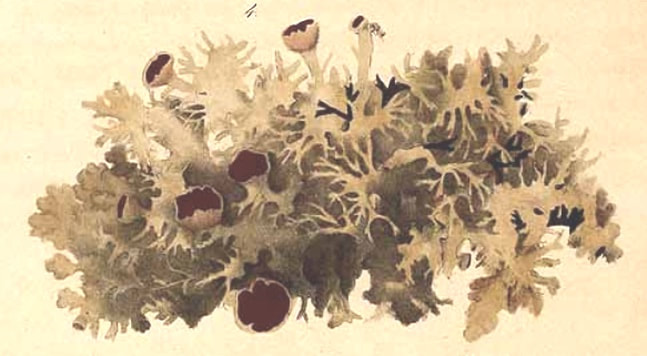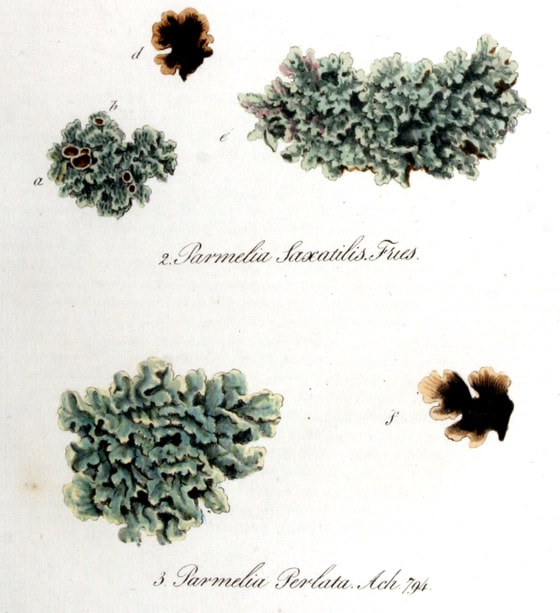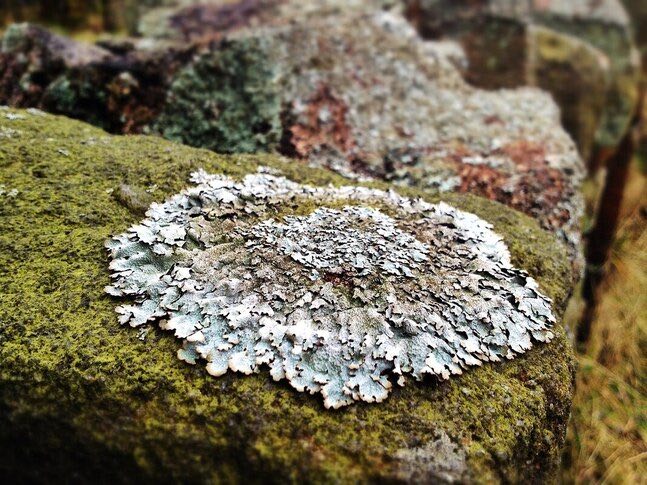Sentry Page Protection
Parmelia, Rock Moss
Stone Flower, Rock Moss
Parmelia tinctorum:
–Rdo dreg རྡོ་དྲེག (Tibetan)
–Mei Yi (TCM)
–Ashmapushpa (, Ayurveda)
Parmelia perlata:
–Shaileya, Saileya, Charela (Ayurveda)
–Ushna, Charela (Unani)
–Karpasi, Kal Pasi (Siddha)
Parmelia saxatilis:
–Shi Hua (TCM)
Parmelia tinctorum:
–Rdo dreg རྡོ་དྲེག (Tibetan)
–Mei Yi (TCM)
–Ashmapushpa (, Ayurveda)
Parmelia perlata:
–Shaileya, Saileya, Charela (Ayurveda)
–Ushna, Charela (Unani)
–Karpasi, Kal Pasi (Siddha)
Parmelia saxatilis:
–Shi Hua (TCM)
Parmelia perlata (as P. perforata)
Verhandlungen der Kaiserlichen Leopoldinisch-Carolinischen Akademie der Naturforscher;
Nova acta physico-medica academiae caesareae leopoldino-carolinae naturae curiosorum (1841-1843)
Verhandlungen der Kaiserlichen Leopoldinisch-Carolinischen Akademie der Naturforscher;
Nova acta physico-medica academiae caesareae leopoldino-carolinae naturae curiosorum (1841-1843)
Parmelia saxatilis (top), P. perlata (bottom)
Flora Batava of Afbeelding en Beschrijving van Nederlandsche Gewassen, X Deel. (1849)
Flora Batava of Afbeelding en Beschrijving van Nederlandsche Gewassen, X Deel. (1849)
Botanical name:
Parmelia spp.
It has been stated that only aromatic species are used in Ayurveda
In Tibetan Medicine, 5 varieties of Lichen (Rock Moss) are recognized, based on their color: Red, Yellow, White, Green and Black.
Parts used:
Whole herb (Thallus)
The white variety is best.
Temperature & Taste:
Cool (Neutral), dry. Sweet, Bitter. Astringent
"A group of physicians are of the opinion that it is Hot in the First and Cold in the Second degree. Another group of physicians says that it is Cold and extremely Dry". (Avicenna)
Parmelia spp.
- P. tinctorum is used in Tibet
- P. perlata (syn. P. parietina, P. perforata, Lichen odoriferous, L. rotundatus) used in Ayurveda and Unani
- P. saxatilis is used in TCM
- P. kamtschadalis (syn. P. cirrhata), and P. longissima in Unani, used synonymously with P. perlata
It has been stated that only aromatic species are used in Ayurveda
In Tibetan Medicine, 5 varieties of Lichen (Rock Moss) are recognized, based on their color: Red, Yellow, White, Green and Black.
Parts used:
Whole herb (Thallus)
The white variety is best.
Temperature & Taste:
Cool (Neutral), dry. Sweet, Bitter. Astringent
"A group of physicians are of the opinion that it is Hot in the First and Cold in the Second degree. Another group of physicians says that it is Cold and extremely Dry". (Avicenna)
Uses:
1. Clears Heat, Resists Poison:
-used against various Poisons (Tibet, Ayurveda); Charaka prescribed it for Toxicosis and Fever
-Toxic Sores and Swellings
-Chronic Fever (Tibet), Fever, 'Burning syndrome', Fever or Heat disease with Thirst (Ayurveda)
-Diarrhea, Dysentery (Unani, Ayurveda, Tibet)
-Gonorrhea (TCM)
-Phlegm-Heat (Kapha-Pitta) diseases (Ayurveda)
-Red variety is regarded as best for Toxin and Heat diseases (Tibet)
2. Strengthens the Stomach:
-Nausea, Vomiting, Poor Appetite (Tibet, Ayurveda)
-regarded as a Stomach tonic in Unani
3. Nourishes Blood and Essence, Benefits the Eyes:
-poor or failing Eyesight
-the ashes are applied to the Eyes to promote vision in Unani
-"It clears the vision". (Avicenna)
-the fine powder is applied to the Eyes for glaucoma (Tibet)
-White variety is regarded as best for the eyes in Tibetan Medicine
-Wasting diseases
-improves complexion and nourishes Skin
-used in cosmetic preparations to beautify skin (Ayurveda)
4. Strengthens the Kidneys, Promotes Urine:
-Painful or Suppressed Urine, Urinary Stones (Ayurveda)
-pain and weakness of the Lumbar (TCM)
-Premature Ejaculation, Nocturnal Emission, Spermatorrhea (Ayurveda)
-Kidney and Liver tonic (TCM, Unani)
5. Moves the Blood, Stops Bleeding:
-Spotting or Flooding (TCM)
-Amenorrhea, Dysmenorrhea (Ayurveda, Unani)
-bleeding after Trauma
-"Dioscorides stated that it Stops Bleeding". (Avicenna)
-regarded as a Heart tonic (Ayurveda, Unani)
6. Externally:
–topically for Lumbar pain (Ayurveda)
-Arthritis, Rheumatism, Sciatica (Unani)
-topically in cosmetic preparations
-as a hair wash to beautify and strengthen the hair (Ayurveda)
-Itchiness, chronic skin diseases, Ulcer (Ayurveda)
-powder is applied to promote healing of Wounds (Tibet, Ayurveda, Unani)
-applied over the Kidneys for retention of Urine; said to (Ayurveda, Unani)
-applied to the forehead or used as a snuff in Headaches (Ayurveda)
-also burnt as Incense for Headache and to promote rest (Ayurveda, Unani)
-ashes are applied to inflammation and tearing of the eyes, and to strengthen Vision (Unani)
-Burns and Scalds (TCM)
Dose:
Powder: 1–3 grams
Decoction: 3–5 grams
An infusion of 1 in 20 water is taken in doses of 1–4 drams
As a poultice it is boiled until soft, then mashed and applied
Comment:
The above-mentioned species are all similar in appearance and have similar uses in the various traditions, only the emphasis in use being different.
Corrective:
Pimpinella acuminata (Unani)
Substitute:
1. "Caraway in equal quantity is the substitute of Ushnah" (Avicenna)
2. "Galen said that Stone Flower is similar to Duck Weed". (Avicenna)
Preparation:
"Induces sleep if it has been soaked in wine". (Avicenna)
Powder: 1–3 grams
Decoction: 3–5 grams
An infusion of 1 in 20 water is taken in doses of 1–4 drams
As a poultice it is boiled until soft, then mashed and applied
Comment:
The above-mentioned species are all similar in appearance and have similar uses in the various traditions, only the emphasis in use being different.
Corrective:
Pimpinella acuminata (Unani)
Substitute:
1. "Caraway in equal quantity is the substitute of Ushnah" (Avicenna)
2. "Galen said that Stone Flower is similar to Duck Weed". (Avicenna)
Preparation:
"Induces sleep if it has been soaked in wine". (Avicenna)
Main Combinations:
1. Fever, Heat diseases of the Organs, Skin or Muscles, Erysipelas etc., Parmelia with Sandalwood, Camphor, Tabasheer, Meconopsis (as in Camphor 25)
2. Blood Heat and Toxin, Parmelia perlata is combined with Sealed Earth (Unani)
3. Bleeding, Parmelia perlata is combined with Red Earth
4. Arthritis, Rheumatism, Sciatica, Parmelia perlata with Madder, Cyperus rotundus, Clove, Calamus, Cinnamon in Sesame oil (as in Roughan-e-Surkh of Unani medicine)
Major Formulas:
Camphor 25 (Tibetan)
Roughan-e-Surkh (Unani Medicine)
Cautions:
Long-term use is said to be detrimental to the Intestines (due to its astringent effect)
Main Preparations used:
Long-term use is said to be detrimental to the Intestines (due to its astringent effect)
Main Preparations used:



